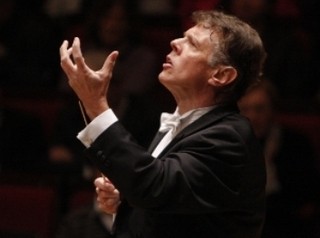|
Back
Sculpting An Afternoon of Joy New York
Isaac Stern Auditorium, Carnegie Hall
05/18/2014 -
György Ligeti: Atmosphères
Alban Berg: Violin Concerto
Johannes Brahms: Symphony No. 2 in D Major, Opus 73
Gil Shaham (Violin)
Bavarian Radio Symphony Orchestra, Mariss Jansons (Chief Conductor)

M. Jansons (© Bavarian Radio Symphony Orchestra)
While other musical events precluded attendance at the first two concerts of the Bavarian Radio Symphony Orchestra (BRSO) last week, their triumph set bells ringing. Specifically telephone bells, as well as a New Yorker adulation and e-mails that I should give up everything else to hear them.
At their final performance yesterday afternoon, it was almost apparent why this relatively young orchestra was praised so widely. The “almost” is because the BRSO doesn’t have the evident adjectives. They aren’t necessarily the most exciting, their strings aren’t the shiniest, their brass isn’t the most brassy, their ensemble virtuosity isn’t worthy of knowing glances of appreciation.
Rather, the BRSO has a more subtle factor. In two of their three works, they showed a suppleness, a sense of grace under the most intense pressure. Mariss Jansons didn’t push his orchestra into revelations. He molded, he sculpted them. If one thought of Michelangelo, it wasn’t the Michelangelo of the celestial ceiling, but the David-sculptor, engraving curvatures and angles seemingly with last-minute inspirations.
The one exception, György Ligeti’s Atmosphères, could not, of course, have given the illusion of sudden inspiration. The density of the sounds was ideal for the futuristic perfectionism of Kubrick’s 2001, but only the most controlled conductor can offer the shape in a concert hall.
The first concert-hall Ligeti I ever heard was his Cello Concerto conducted by David Atherton in Hong Kong, and even then I reviewed it as a work for the quantum universe. That was an educated guess. Today, knowing a fraction more about quantum physics and the composer himself, it is obvious that even if Ligeti was working on simply ending durations and relationships, creating pure sound, this was a quantum concept. Atmosphères is, yes, either an event without movement, or a movement without an event.
But it must be hell for a conductor to get it exactly right. Not like herding cats, but controlling gases. Yet Mr. Jansons got his orchestra to ease in an out of his vaporous sound patterns with true certitude. The only problem is that listening to this in Carnegie Hall, I can never again hear it on an electronic devices.
When describing “last minute inspirations”, I obviously didn’t mean they were unrehearsed. Yet when listening to Gil Shaham–who has recently almost made a career out of playing concertos of the 1930’s–play the Berg Violin Concerto, one had the feeling that he was embracing each and every note as if it was the first time he approached the music.

G. Shaham (© Boyd Hagen)
The Berg is atonal, yes, but where Ligeti’s work brought atonalism to its nth possibility, Alban Berg was never afraid to depart from the “rule”. And Gil Shaham was never afraid to say, on his 1699 “Countess Polignac” Stradivarius, “This work was dedicated to the memory of an angel, so why not play it like a Medieval angelic conception?”
That first tone row on his open strings broadened into the sweetest tones, which soared over the orchestra, or, more meaningfully, worked with the orchestra. Mr. Shaham, never ingratiating but always warm and endearing on the stage, strolled, prompted, smiled to the Concertmaster, proceeded to become one with the work.
Messrs Shaham and Jansons seemed to have the same conception of the Violin Concerto. To give it shape and depth, never ever to exaggerate its more eccentric moments–the waltz was a shadow of a waltz, the Bach interpolation came in as if it was the obvious choice.
At times one felt that Mr. Shaham was catering a wee bit too far in catering to the romantic aspects of the piece, to give some excess Tchaikovsky vibrato in the romance of the first movement. Yet this is like saying that beauty isn’t enough.
At the end, when Mr. Shaham signaled to the Concertmaster, when the strings began to double the soloist’s line, when the orchestra rose up, and then died down again, it left Mr. Shaham soaring slowly the top, to the quiet memory of that angel.
Such emotion seems far-fetched in our Quantum Nihilistic Age. Listening to Mr. Shaham, one knows that feeling needs no age or era.
The BRSO was sculpted into visions of vernal tranquility for the Brahms Second Symphony. Quiet, lovely, bucolic horn falls, a conductor needing no idiosyncratic measures to make its mark. Maybe Mr. Jansons felt that such repose needed a tiny kick in the derrière, and that he added in the Allegro con spirito. The spirit was willing, and the orchestra finished with a zesty (if always cultivated) aplomb.
Harry Rolnick
|